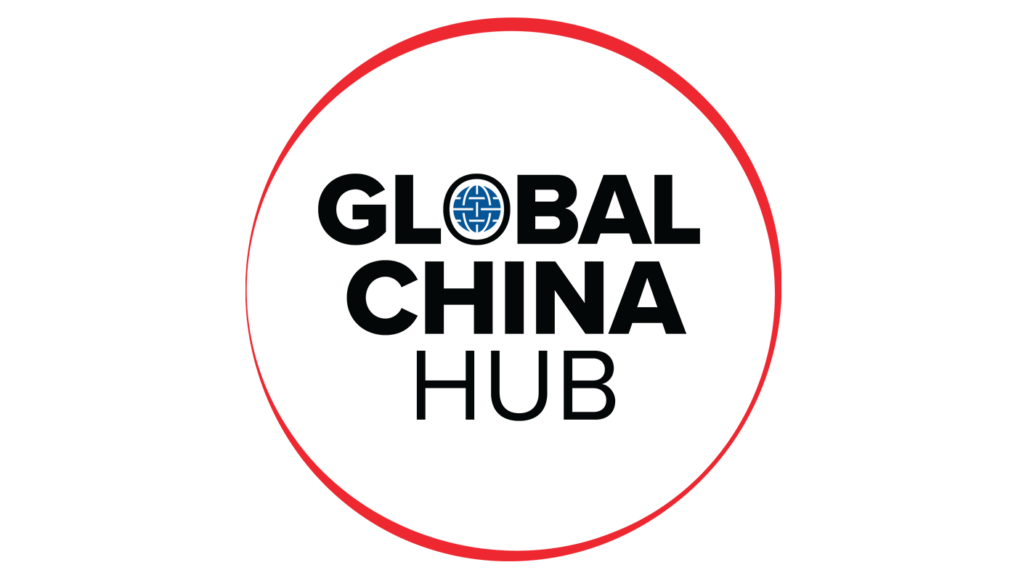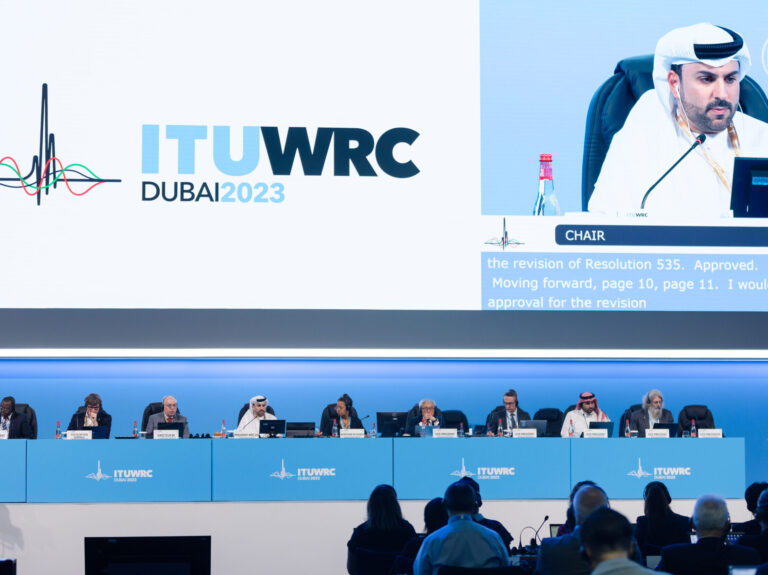April 12, 2024
Analyzing the outcomes of the 2023 World Wireless Communications Conference and its impact on the US-China 5G competition
To: The security and technology communities of the United States and its allies and partners
from: Ngor Luong
date: April 12, 2024
subject: Analyzing the outcomes of the 2023 World Wireless Communications Conference and its impact on the US-China 5G competition
In February 2024, the Atlantic Council’s Global China Hub hosted a closed-door workshop bringing together policy and industry experts to review the outcomes of the 2023 World Radiocommunication Conference (WRC), held in Dubai from November 20 to December 15, 2024, and to discuss China’s ambitions for leadership in 5G technology and the economic and security implications for the United States, its allies, and partners. This memorandum summarizes key insights from the workshop.
Strategic Background
5G, the fifth generation of mobile and cellular networks, is a disruptive technology essential to enhancing digital connectivity for improved efficiency and productivity in commercial economies and the military. Enhanced wireless connectivity can support a variety of industries and sectors, including autonomous vehicles, advanced robotics, and smart agriculture. In addition, such connectivity can improve intelligence, surveillance, and reconnaissance (ISR) systems and streamline command and control in military operations. Given these benefits of 5G, both the United States and China have sought to gain global leadership in this technology. Countries that can fully deploy nationwide 5G networks will be able to reap the benefits of this technology domestically and lead in setting international standards.
The development and deployment of 5G or next-generation wireless technologies requires not only the construction of new infrastructure but also a significant allocation of finite radio frequency spectrum. Allocating sufficient amounts of spectrum to national 5G networks is critical to the success of those networks and their ability to lead the development of innovation across industries and sectors. 5G networks can be deployed in multiple ranges of frequency bands – low, mid and high – with varying degrees of coverage and speed. Low-band spectrum (below 1 GHz) offers good coverage but lacks bandwidth for large amounts of data transfer. Meanwhile, high-band frequencies (mmWave bands above 24 GHz) support the fastest broadband speeds over short distances. Mid-band spectrum (1-24 GHz) is ideal for 5G use in urban and rural areas as it offers both coverage and speed. In the context of 5G deployment, the lower mid-band (3-8.4 GHz) offers a better balance of speed and coverage than the upper mid-band (8.4-24 GHz).
Chinese telecommunications companies such as Huawei and ZTE are deploying 5G using mid-band spectrum below 6 GHz, which is suitable for their country’s network infrastructure. In 2023, China allocated spectrum in the 6 GHz band for international mobile telecommunications (IMT). Meanwhile, the United States has reserved more high-band spectrum, and the Federal Communications Commission (FCC) has auctioned more of this band than all other flexible use bands combined. The bands suitable for 5G are the lower part of the mid- and low-bands available in the country, some of which are made available by the FCC. Meanwhile, 6 GHz is reserved for existing licensed operators operating in these bands, such as satellite operators and government services, who are concerned about possible harmful interference or possible relocation to another band. The success of 5G deployment depends on efficient spectrum allocation within the country and international harmonization to ensure interoperability between different countries.
WRC23 Results
The International Telecommunication Union (ITU) convened 163 countries for its quadrennial WRC in Dubai in November-December 2023 to govern the use of radio frequency spectrum across borders, ensure equal access, and prevent interference. The WRC identified parts of the 6 GHz band for IMT applications and the IMT bands above 7.125 GHz for future study. The U.S. delegation to the WRC successfully protected U.S. interests in 6 GHz IMT by leaving it unlicensed under ITU regulations in its own region. Meanwhile, China has advocated for this band to be harmonized for 5G at WRC23 to improve its company’s position in the global 5G market. Global harmonization of 6 GHz has two implications for the U.S. First, with 6 GHz currently reserved for unlicensed use, the U.S. may have less mid-band spectrum available than other countries, such as China, which has allocated 6 GHz for commercial use. Secondly, commercial use will likely see greater demand for 5G equipment capable of 6GHz than for unlicensed technology equipment.
Although the U.S. did a good job of laying out its spectrum policy priorities at the WRC, workshop participants agreed that a more proactive agenda must be developed to achieve spectrum harmonization with other countries. As the WRC meets every four years, it is crucial that the U.S. maintains momentum with allies and partners to devise strategies to counter China’s global influence in spectrum policy while protecting its domestic interests.
China’s domestic support and international efforts for 5G
In its 14th Five-Year Plan (2021-2025), China aims to build a modern infrastructure system by accelerating the deployment of 5G networks and developing technologies for future 6G deployment. As a result, Chinese telecommunications operators are accelerating the deployment of 5G in the country, and plan to build 3.2 million 5G base stations in China by September 2023, a nearly 250% increase from the 916,000 base stations in July 2021.
The Chinese government politically and financially supports the country’s leading companies. Government subsidies, for example, helped Huawei advance as a leader in the 5G field, enabling it to secure 10% of the global mobile wireless market by the mid-2000s. China has also taken a proactive approach to spectrum allocation, involving industry and military officials, as enshrined in the Radio Management Regulations issued by the State Council and the Central Military Commission. The government selected mid-band spectrum allocations, which are considered ideal for 5G deployment as they offer the best compromise between speed and coverage.
The Chinese government is also helping its telecommunications carriers expand into international markets with export finance loans. Chinese state banks are providing loans to other countries in exchange for contracts to buy Huawei equipment. Meanwhile, China is encouraging its carriers to expand their influence in international standard-setting organizations, including in shaping how to open up spectrum, as outlined in its “China Standard 2035” plan.
Workshop participants expressed concern about China’s ambitions to dominate in 5G. There are also concerns about China’s efforts to seek global spectrum harmonization to favor its domestic operators, especially in the 6 GHz band. In addition, Huawei has already entered the Group of 77 (G77) hardware market with government-backed loans. There are also concerns about cyber vulnerabilities in its telecommunications and cloud infrastructure, despite Huawei’s reputation as a one-stop shop for many network and telecom operators. Workshop participants also noted that China’s slowing economic growth could make it difficult for it to continue offering below-market rate credits.
Impact on the United States, its allies and partners
The United States and its allies and partners have a unique opportunity to address the challenges posed by China’s attempts to dominate 5G. The United States must leverage existing tools and strengthen bilateral and multilateral coordination with allies and partners.
The United States has its own means to counter China’s international influence in 5G. Domestically, the FCC’s removal and replacement program, which was meant to remove Chinese information and communications technology products from U.S. networks, is currently facing a $3 billion funding shortfall. Meanwhile, the National Spectrum Strategy identified the 7-8 GHz mid-band as one of the spectrum bands that merits further detailed study to identify spectrum availability and opportunities for civilian use. This effort could address the issue of disparity in 6 GHz mid-band spectrum availability between the United States and the rest of the world, due to the U.S.’s preference to leave the 6 GHz band unlicensed. There is evidence that 7-8 GHz, adjacent to 6 GHz and able to participate in the same “tuning range,” offers comparable benefits. Workshop participants noted that it is important for the United States to conduct these studies and coordinate early with other countries to take the lead in the 7-8 GHz band ahead of the next WRC. Developing a domestic policy on both 5G equipment and spectrum is a critical first step in clarifying U.S. priorities and facilitating information sharing and better coordination with allies and partners.
U.S. interests in spectrum harmonization underscore the importance of aligning these interests with those of U.S. allies and partners. The race for 5G leadership involves more than just the United States and China. Several key players, including Europe, are also interested in opening up the 6 GHz band, which China proposed at WRC23. While the Indian government has yet to identify 6 GHz spectrum for 5G expansion, major Indian mobile carriers have already proposed it. For its part, the United States needs to quickly coordinate with key allies and partners to avoid developing 5G in isolation.
Beyond bilateral relations, it is also essential for the United States to align its claims with those of other countries in the region. Cooperation on strategic technologies such as 5G has a central place in the Quad, a strategic security dialogue that includes the United States, Japan, Australia, and India. One of the Quad’s priorities is to ensure that “regional countries are not left behind in the evolution of communications markets and network architectures.” In South America and Africa, 5G discussions often revolve around equipment, but countries in these regions have begun the process of improving spectrum allocations.
The United States needs to better integrate perspectives from other regions to develop a compatible 5G roadmap, reap the benefits of the technology, and maintain its leadership in the field.
About the Author
Ngor Luong Luong is an adjunct fellow at the Atlantic Council’s Global China Hub and a senior research analyst at Georgetown University’s Center for Security and Emerging Technologies, focusing on China’s science and technology ecosystem, AI investment trends, and AI diplomacy in the Indo-Pacific region. Previously, he worked at the Center for American Progress, researching China’s industrial policy and 5G.

of Global China Hub Leveraging and expanding work on China across the Atlantic Council’s 15 other programs and centers, we will research and devise coordinated solutions to the global challenges posed by China’s rise.
Image: ITU World Radiocommunication Conference 2023 (WRC-23) ©ITU/C.Chacko


